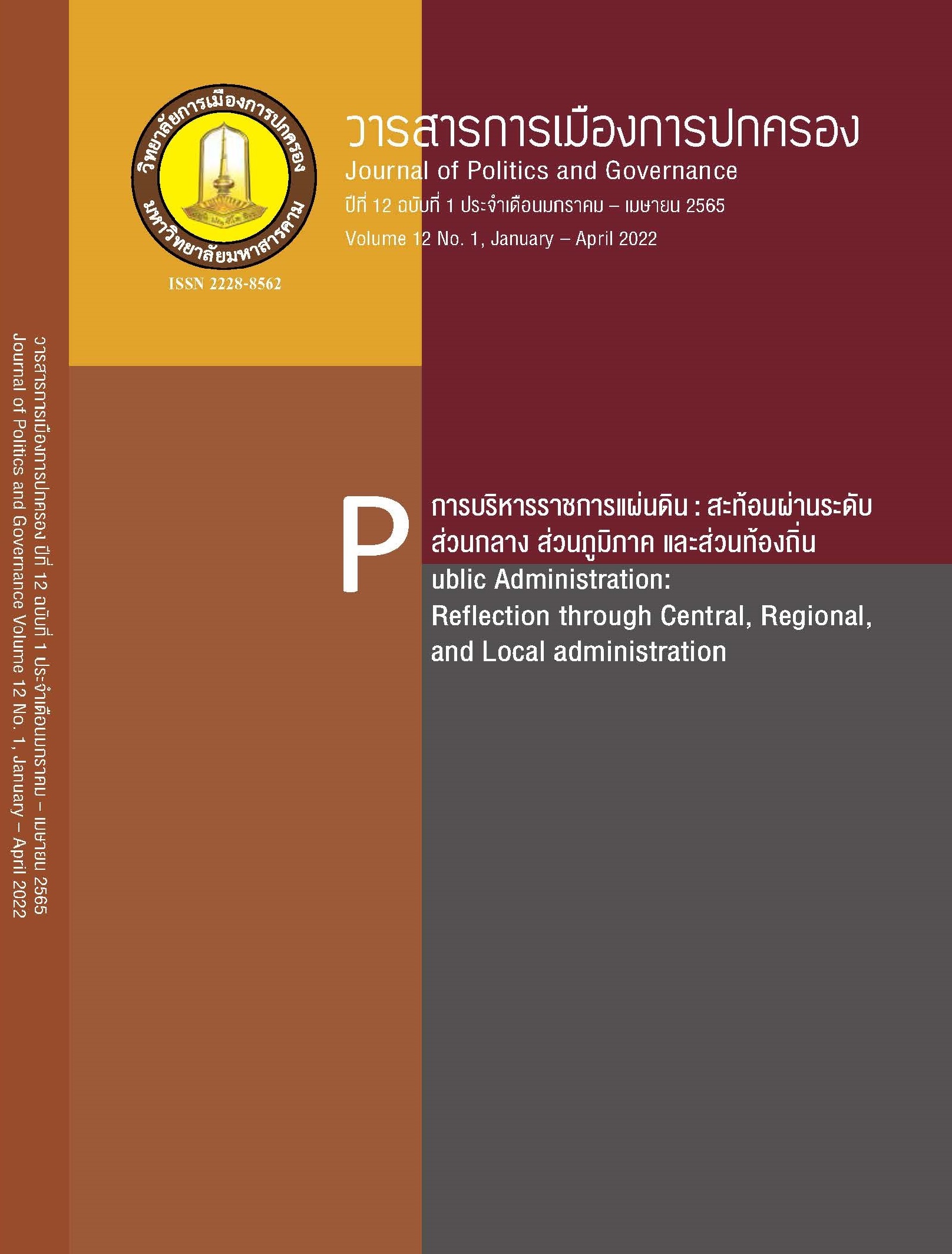The Capacity Building for Flood Disaster Risk Reduction of Ubon Ratchathani City Municipality and Warinchamrab Town Municipality, Ubon Ratchathani Province
Main Article Content
Abstract
The objectives of this research are to 1) study the flood risk reduction methods of Ubon Ratchathani City Municipality and Warinchamrab Town Municipality, 2) the potentials and limitations of flood management of Ubon Ratchathani City Municipality and Warinchamrab Town Municipality, and 3)suggest the capacity buildings guidelines and measures for flood risk reduction of Ubon Ratchathani City Municipality and Warinchamrab Town Municipality, Ubon Ratchathani Province. The qualitative research and participatory action research were applied for this research. The key informants were selected specifically; executives, supervisors, and officials of Ubon Ratchathani City Municipality and Warinchamrab Town Municipality which related to disaster prevention and mitigation total 22 persons; executives and officials of Ubon Ratchathani Provincial Disaster Prevention and Mitigation Office total 2 persons; and leaders or community representatives in flood risk areas total 51 persons. The research instrument was interview form; collected by interview, focus group, observations, survey, and participatory action forum; and analyzed by grouping, classification, analysis, and content synthesis. The results revealed that 1) Ubon Ratchathani City Municipality and Warinchamrab Town Municipality have used the structural flood risk reduction, such as floodwall, and the non-structural flood risk reduction, such as water levels monitoring, evacuation warning, and special plan for rescuing flood victims. 2) Both municipalities have the good potential for flood management in during flood. However, there are limitations of flood management, such as could not to disburse budgets for flood management before the disaster zones announcing and the evacuation warning that not yet could to build confidence for the community. 3) Recommendations to municipalities for the structural flood risk reduction, such as raising the height of floodwall, and building the two-story house for the community. Whereas, the non-structural flood risk reduction, such as the training about a water level data awareness and understanding, adopting of flood level data and statistics in 2019 as a base for the future flood management, acquisition the more temporary evacuation areas, and evacuation warning improvement to be more accurate and reliable.
Article Details
References
กรมทรัพยากรธรณี กระทรวงทรัพยากรธรรมชาติและสิ่งแวดล้อม. (2553). การจำแนกเขตเพื่อการจัดการด้านธรณีวิทยาและทรัพยากรธรณี จังหวัดอุบลราชธานี. กรุงเทพฯ: กระทรวงทรัพยากรธรรมชาติและสิ่งแวดล้อม.
คณะวิทยาศาสตร์ มหาวิทยาลัยเกษตรศาสตร์. (2556). รายงานการศึกษาฉบับสมบูรณ์ โครงการศึกษาวิจัยการประยุกต์ใช้ระบบสารสนเทศภูมิศาสตร์ เพื่อการวิเคราะห์และวางแผนจัดการพื้นที่เสี่ยงอุทกภัย จังหวัดอุบลราชธานี. กรุงเทพฯ: มหาวิทยาลัยเกษตรศาสตร์.
ชูวงศ์ อุบาลี. (2557). การบริหารจัดการภัยพิบัติ: บทบาทขององค์กรปกครองส่วนท้องถิ่นจังหวัดจันทบุรี. สำนักงานผู้ตรวจการแผ่นดิน, 7(2), 51-69.
ทวิดา กมลเวชช. (2555). คู่มือการจัดการภัยพิบัติท้องถิ่น. กรุงเทพฯ: สถาบันพระปกเกล้า.
รัชนี ดิ้นเมือง. (2554). การป้องกันและแก้ไขปัญหาอุทกภัยเชิงบูรณาการขององค์การบริหารส่วนตำบลบางหมาก อำเภอกันตัง จังหวัดตรัง รายงานการศึกษาอิสระปริญญารัฐประศาสนศาสตรมหาบัณฑิต สาขาวิชาการปกครองท้องถิ่น วิทยาลัยปกครองท้องถิ่น. มหาวิทยาลัยขอนแก่น.
วรัทยา พรมชาติ. (2556). ความพร้อมในการจัดการภัยพิบัติทางธรรมชาติขององค์กรปกครองส่วนท้องถิ่นในจังหวัดเชียงใหม่, การประชุมหาดใหญ่วิชาการ ครั้งที่ 4. มหาวิทยาลัยหาดใหญ่.
วันทนีย์ คงสมบูรณ์. (2551). หลักการและแนวทางการจัดการสาธารณภัย. ใน เอกสารการสอนชุดวิชาการจัดการสาธารณภัย. หน่วยที่ 8 (พิมพ์ครั้งที่ 2). นนทบุรี: สำนักพิมพ์มหาวิทยาลัยสุโขทัยธรรมาธิราช.
อุทัย เลาหวิเชียร และสุวรรณี แสงมหาชัย. (2560). การบริหารการป้องกันและแก้ไขปัญหาอุทกภัยในเขตกรุงเทพมหานคร. วารสารเกษมบัณฑิต, 18(2), 111-127.
Adedeji, O. H., Odufuwa, B. O., & Adebayo, O. H. (2012). Building capabilities for flood
disaster and hazard preparedness and risk reduction in Nigeria: Need for spatial planning and land management. Journal of Sustainable Development in Africa. 14(1), 45-58.
Amaratunga, D. (n.d.). Capacity building framework for disaster risk reduction. Retrieved March 21, 2018, from http://www.salford.ac.uk/__data/ assets/pdf_file/0008/394532/ Capacity- building-framework-for-Disaster-Risk-Reduction.pdf
Capacity for Disaster Reduction Initiative. (2012). Basics of Capacity Development for Disaster Risk Reduction. Retrieved May 30, 2018, from http://www.rootchange. org/about_us/resources/publications/CADRI_brochure%20final.pdf
Coppola, P. D. (2007). Introduction to international disaster management. China: Elsevier.
Davies, T., Beaven, S., Conradson, D., Densmore, A., Gaillard, JC., Johnston, D.,…Wilson, T. (2015). Toward disaster resilience: A scenario-based approach to co-producing and integrating hazard and risk knowledge. International Journal of Disaster Risk Reduction, 13, 242-247.
Fakhruddin, S.H.M., Kawasakib, A., & Babel., M. S. (2015). Community responses to flood early warning system: Case study in Kaijuri Union, Bangladesh. International Journal of Disaster Risk Reduction, 14(4), 323-331.
Hagelsteen, M., & Becker, P. (2014). Forwarding a challenging task: Seven elements for Capacity development for disaster risk reduction. Planet@Risk, 2(2), 94-97.
Hartwig, K., Pashman, J., Cherlin, E., Dale, M., Callaway, M., Czaplinski, C.,...Bradley, E. H. (2008). Hospital management in the context of health sector reform: A planning model in Ethiopia. International Journal of Health Planning and anagement, 23, 203–218.
International Labour Organization. (2005). Capacity Building and Training for Disaster Risk Reduction in Recovery Management. Retrieved from http://www.recoveryplatform.org/assets/meetings_trainings/sideevent_iatf_12/ 200511_ilo_dis.pdf
Japan International Cooperation Agency. (2008). Building Disaster Resilient Societies. Retrieved from http://www.jica.go.jp/english/our_work/ thematic _issues/water/pdf/cooperation_01.pdf
Khan, H., Vasilescu, L., & Khan, A. (2008). Disaster management cycle- A theoretical approach. Retrieved February 20, 2018, from http://www.mnmk.ro/ documents/2008/2008-6.pdf
Krishnaveni, R., & Sujatha, R. (2013). Institutional capacity building: A systematic approach. Journal of Indian Management, October – December, 17-23.
Kühl, S (2009). Capacity development as the model for development aid organizations. Development and Change, 40(3), 551-577.
McBean, G., & Rodgers, C. (2010). Climate hazards and disasters: The need for capacity building. WIREs Climate Change, 1(6), 871-884.
Sitko, P. (2012). A critical analysis of emergency capacity building: The work of the ECB project. (Master thesis). Oxford Brookes University, UK.
Ulum, M. C., & Chaijaroenwatana, B. (2011). Governance and capacity building of handling the flood issue in Bojonegoro Municipality, Indonesia. Journal of Politics and Governance, 3(1), 18-34.
United Nations Educational, Scientific and Cultural Organization. (2006). Guidebook for planning education in emergencies and reconstruction. Retrieved May 3, 2018, from http://www.preventionweb.net/files/8401_guidebook.pdf
United Nations International Strategy for Disaster Reduction. (2009). 2009 UNISDR Terminology on Disaster Risk Reduction. Retrieved May 21, 2018, from https://www.unisdr.org/files/7817_UNISDRTerminologyEnglish.pdf
United Nations International Strategy for Disaster Reduction. (2004). Disaster risk reduction, governance and development. Retrieved from http://www.unisdr.org/ files/8546_governacedevelopment1.pdf
Walters, H. (2007). Capacity development, institutional change and theory of change: What do we mean and where are the linkages. Retrieved from http://portals.wi.wur.nl/files/docs/successfailuredevelopment/Walters_ Capacity DevelopmentConceptPaperFIN.pdf
White, B. A., & Rorick, M. M. (2010). Cost-benefit analysis for community-based: Disaster risk reduction in Kailali, Nepal. Retrieved from https://www.mercycorps.org/sites/default/files/mc-cba_report-final-2010-2.pdf
Wongpreedee, A., & Sudhipongpracha, T. (2014). Disaster management that works: Flood management strategy and implementation in Nakorn Pakkred Municipality. NIDA Case Research Journal, 6(1), 1-32.


